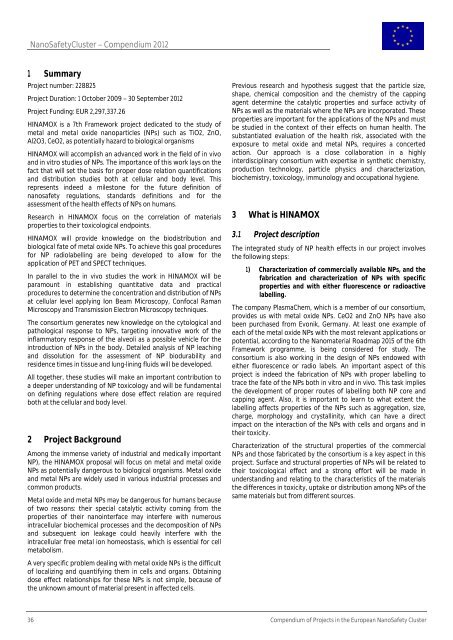Timing, hosts and locations of (grouped) events of NanoImpactNet
Timing, hosts and locations of (grouped) events of NanoImpactNet
Timing, hosts and locations of (grouped) events of NanoImpactNet
You also want an ePaper? Increase the reach of your titles
YUMPU automatically turns print PDFs into web optimized ePapers that Google loves.
NanoSafetyCluster – Compendium 2012<br />
1 Summary<br />
Project number: 228825<br />
Project Duration: 1 October 2009 – 30 September 2012<br />
Project Funding: EUR 2,297,337.26<br />
HINAMOX is a 7th Framework project dedicated to the study <strong>of</strong><br />
metal <strong>and</strong> metal oxide nanoparticles (NPs) such as TiO2, ZnO,<br />
Al2O3, CeO2, as potentially hazard to biological organisms<br />
HINAMOX will accomplish an advanced work in the field <strong>of</strong> in vivo<br />
<strong>and</strong> in vitro studies <strong>of</strong> NPs. The importance <strong>of</strong> this work lays on the<br />
fact that will set the basis for proper dose relation quantifications<br />
<strong>and</strong> distribution studies both at cellular <strong>and</strong> body level. This<br />
represents indeed a milestone for the future definition <strong>of</strong><br />
nanosafety regulations, st<strong>and</strong>ards definitions <strong>and</strong> for the<br />
assessment <strong>of</strong> the health effects <strong>of</strong> NPs on humans.<br />
Research in HINAMOX focus on the correlation <strong>of</strong> materials<br />
properties to their toxicological endpoints.<br />
HINAMOX will provide knowledge on the biodistribution <strong>and</strong><br />
biological fate <strong>of</strong> metal oxide NPs. To achieve this goal procedures<br />
for NP radiolabelling are being developed to allow for the<br />
application <strong>of</strong> PET <strong>and</strong> SPECT techniques.<br />
In parallel to the in vivo studies the work in HINAMOX will be<br />
paramount in establishing quantitative data <strong>and</strong> practical<br />
procedures to determine the concentration <strong>and</strong> distribution <strong>of</strong> NPs<br />
at cellular level applying Ion Beam Microscopy, Confocal Raman<br />
Microscopy <strong>and</strong> Transmission Electron Microscopy techniques.<br />
The consortium generates new knowledge on the cytological <strong>and</strong><br />
pathological response to NPs, targeting innovative work <strong>of</strong> the<br />
inflammatory response <strong>of</strong> the alveoli as a possible vehicle for the<br />
introduction <strong>of</strong> NPs in the body. Detailed analysis <strong>of</strong> NP leaching<br />
<strong>and</strong> dissolution for the assessment <strong>of</strong> NP biodurability <strong>and</strong><br />
residence times in tissue <strong>and</strong> lung-lining fluids will be developed.<br />
All together, these studies will make an important contribution to<br />
a deeper underst<strong>and</strong>ing <strong>of</strong> NP toxicology <strong>and</strong> will be fundamental<br />
on defining regulations where dose effect relation are required<br />
both at the cellular <strong>and</strong> body level.<br />
2 Project Background<br />
Among the immense variety <strong>of</strong> industrial <strong>and</strong> medically important<br />
NP), the HINAMOX proposal will focus on metal <strong>and</strong> metal oxide<br />
NPs as potentially dangerous to biological organisms. Metal oxide<br />
<strong>and</strong> metal NPs are widely used in various industrial processes <strong>and</strong><br />
common products.<br />
Metal oxide <strong>and</strong> metal NPs may be dangerous for humans because<br />
<strong>of</strong> two reasons: their special catalytic activity coming from the<br />
properties <strong>of</strong> their nanointerface may interfere with numerous<br />
intracellular biochemical processes <strong>and</strong> the decomposition <strong>of</strong> NPs<br />
<strong>and</strong> subsequent ion leakage could heavily interfere with the<br />
intracellular free metal ion homeostasis, which is essential for cell<br />
metabolism.<br />
A very specific problem dealing with metal oxide NPs is the difficult<br />
<strong>of</strong> localizing <strong>and</strong> quantifying them in cells <strong>and</strong> organs. Obtaining<br />
dose effect relationships for these NPs is not simple, because <strong>of</strong><br />
the unknown amount <strong>of</strong> material present in affected cells.<br />
Previous research <strong>and</strong> hypothesis suggest that the particle size,<br />
shape, chemical composition <strong>and</strong> the chemistry <strong>of</strong> the capping<br />
agent determine the catalytic properties <strong>and</strong> surface activity <strong>of</strong><br />
NPs as well as the materials where the NPs are incorporated. These<br />
properties are important for the applications <strong>of</strong> the NPs <strong>and</strong> must<br />
be studied in the context <strong>of</strong> their effects on human health. The<br />
substantiated evaluation <strong>of</strong> the health risk, associated with the<br />
exposure to metal oxide <strong>and</strong> metal NPs, requires a concerted<br />
action. Our approach is a close collaboration in a highly<br />
interdisciplinary consortium with expertise in synthetic chemistry,<br />
production technology, particle physics <strong>and</strong> characterization,<br />
biochemistry, toxicology, immunology <strong>and</strong> occupational hygiene.<br />
3 What is HINAMOX<br />
3.1 Project description<br />
The integrated study <strong>of</strong> NP health effects in our project involves<br />
the following steps:<br />
1) Characterization <strong>of</strong> commercially available NPs, <strong>and</strong> the<br />
fabrication <strong>and</strong> characterization <strong>of</strong> NPs with specific<br />
properties <strong>and</strong> with either fluorescence or radioactive<br />
labelling.<br />
The company PlasmaChem, which is a member <strong>of</strong> our consortium,<br />
provides us with metal oxide NPs. CeO2 <strong>and</strong> ZnO NPs have also<br />
been purchased from Evonik, Germany. At least one example <strong>of</strong><br />
each <strong>of</strong> the metal oxide NPs with the most relevant applications or<br />
potential, according to the Nanomaterial Roadmap 2015 <strong>of</strong> the 6th<br />
Framework programme, is being considered for study. The<br />
consortium is also working in the design <strong>of</strong> NPs endowed with<br />
either fluorescence or radio labels. An important aspect <strong>of</strong> this<br />
project is indeed the fabrication <strong>of</strong> NPs with proper labelling to<br />
trace the fate <strong>of</strong> the NPs both in vitro <strong>and</strong> in vivo. This task implies<br />
the development <strong>of</strong> proper routes <strong>of</strong> labelling both NP core <strong>and</strong><br />
capping agent. Also, it is important to learn to what extent the<br />
labelling affects properties <strong>of</strong> the NPs such as aggregation, size,<br />
charge, morphology <strong>and</strong> crystallinity, which can have a direct<br />
impact on the interaction <strong>of</strong> the NPs with cells <strong>and</strong> organs <strong>and</strong> in<br />
their toxicity.<br />
Characterization <strong>of</strong> the structural properties <strong>of</strong> the commercial<br />
NPs <strong>and</strong> those fabricated by the consortium is a key aspect in this<br />
project. Surface <strong>and</strong> structural properties <strong>of</strong> NPs will be related to<br />
their toxicological effect <strong>and</strong> a strong effort will be made in<br />
underst<strong>and</strong>ing <strong>and</strong> relating to the characteristics <strong>of</strong> the materials<br />
the differences in toxicity, uptake or distribution among NPs <strong>of</strong> the<br />
same materials but from different sources.<br />
36 Compendium <strong>of</strong> Projects in the European NanoSafety Cluster






